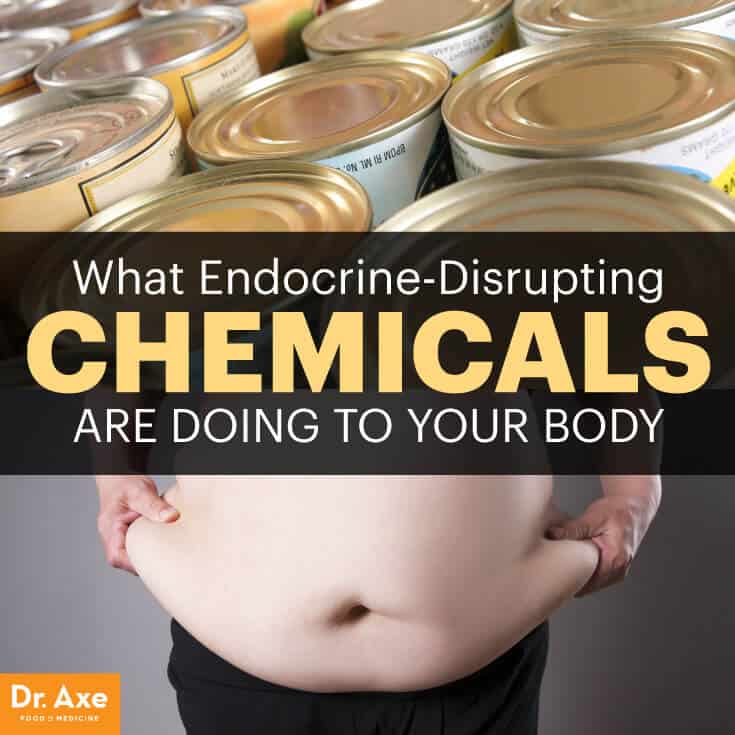How Endocrine Disruptors Destroy Your Body + The Dirty Dozen to Avoid
BPA’s toxic effects are well-publicized. From the lining of canned foods to polycarbonate hard plastics to even the thermal coatings on cash register receipts, this is one of the world’s most proven bad news endocrine disruptors. BPA is linked to everything from hormone-related breast and prostate cancers to polycystic ovarian syndrome and early puberty.
But did you know BPA is just one of at least a thousand chemicals or chemical mixtures that can tinker with our bodies’ delicate hormonal systems, setting us up for disease? (1)
Endocrine-disrupting chemicals (EDCs) like phthalaltes, triclosan and even compounds detected in fish you should never eat are among the 85,000-plus manufactured chemicals in use in the United States. They’re found in everyday products and throughout the environment. For instance, did you know that things like atrazine increase tap water toxicity? It’s true.
Research spanning the last 25 years implicates endocrine disruptors in many health problems, including male reproductive disorders, premature death, obesity and diabetes, neurological impacts, breast cancer, endometriosis, female reproductive disorders, immune disorders, liver cancer, osteoporosis, Parkinson’s symptoms, prostate cancer, and thyroid disorders.
Our current laws clearly aren’t working, and policies are needed to protect people from the harmful consequences of EDC exposure. Until Congress makes it illegal for companies to put such toxic ingredients in our products, it’s unfortunately up to us to do our best to avoid hormone-disrupting chemicals. (2) But it certainly makes a strong case for electing officials who back meaningful chemical reform, doesn’t it? It seems unfair busy families should have to go to these lengths just to stay safe.
What Do Endocrine Disruptors Do?
First we need to ask: What is an endocrine disruptor? According to the National Institute of Environmental Health Science, endocrine disruptors are chemicals that may interfere with the body’s endocrine system and produce adverse developmental, reproductive, neurological and immune effects in both humans and wildlife. The damage is believed to be most severe during prenatal or early pregnancy exposure. (3)
“From the day of conception until an individual is born or hatched, the development of each stage of life is fully under the control of hormones.“Changes that happen during development are far less reversible [than those occurring in an adult]; you can’t go back and rewire the brain.”— the late Theo Colborn, Ph.D., zoologist and founder and president of the Endocrine Disruption Exchange
What Makes Up Your Endocrine System?
Let’s take a step back. How do we define endocrine? What does endocrine mean? The endocrine system, made up of all the body’s different hormones, regulates all biological processes in the body from conception through adulthood and into old age. This includes the: (4)
- development of the brain and nervous system
- growth and function of the reproductive system
- function of metabolism and blood sugar levels
Major components of the endocrine system include:
- female ovaries
- male testes
- pituitary gland
- thyroid gland
- adrenal glands
Other components include the:
- pineal gland
- thymus
- hyperthalamus
- parathyroid glands
- pancreas
Hypothalamus
The hypothalamus links our endocrine and nervous systems together. The hypothalamus drives the endocrine system.
Pituitary Gland
The pituitary gland receives signals from the hypothalamus. This posterior lobe secretes hormones that are made by the hypothalamus. The anterior lobe produces its own hormones. Some of these act on other endocrine glands.
Thyroid Gland
This gland is critical to the healthy development and maturation of humans. It also regulates metabolism.
Adrenal Glands
Made up of two glands, the cortex and medulla, the adrenal glands produce hormones in response to stress. Adrenal glands also regulate blood pressure, glucose metabolism, and the body’s salt and water balance.
Pancreas
The pancreas is responsible for producing glucagon and insulin. Both hormones help regulate the concentration of glucose (sugar) in the blood.
Gonads
The male reproductive gonads are called testes. The female’s reproductive gonads are ovaries. Both produce steroids that affect growth and development and also regulate reproductive cycles and behaviors.
The most prominent gonadal steroids are found in both men and women but at different levels. These include:
- androgens
- estrogens
- progestins
READ MORE AND FIND OUT ABOUT THE DIRTY DOZEN:
Here is to a Healthier You!
Melisa


No comments:
Post a Comment